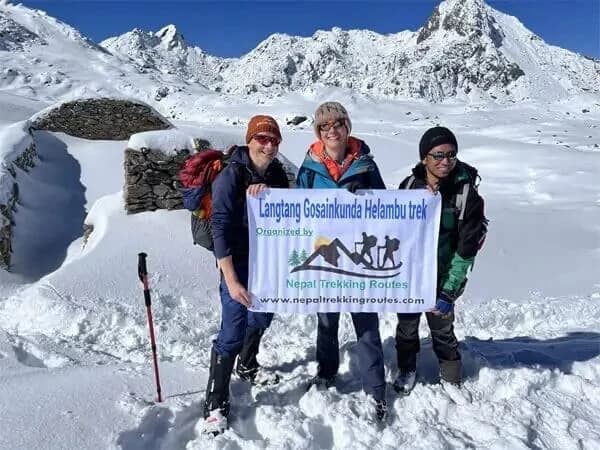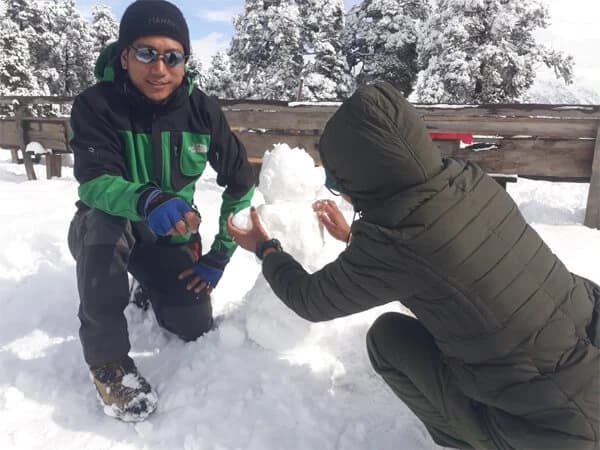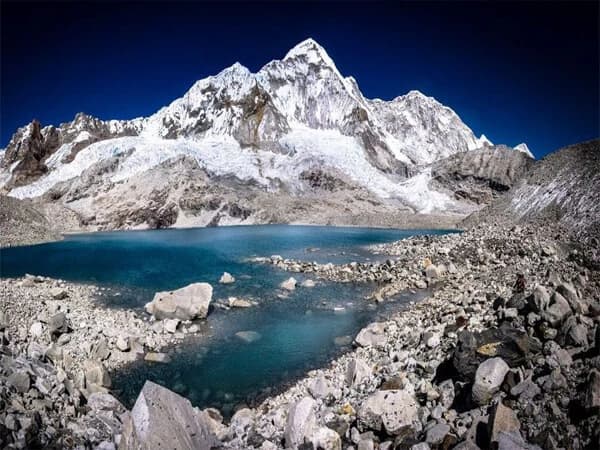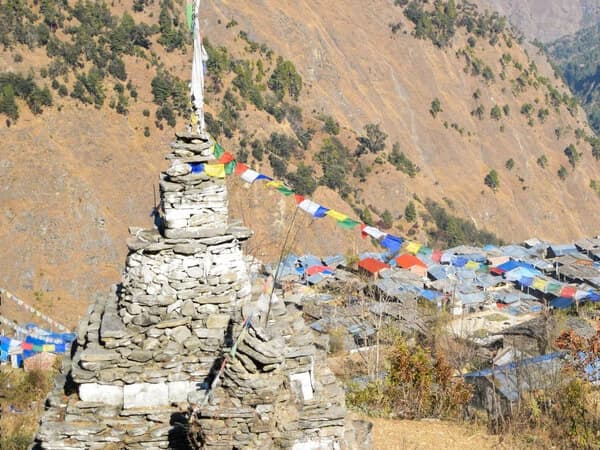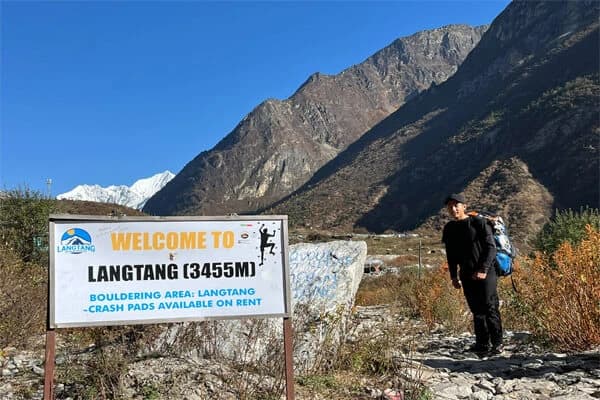The Langtang Valley Trek is a unique adventure in the Himalayas of Nepal. It is one of the most popular trekking destinations after Everest and Annapurna region. It is a short trek closer to the Kathmandu. It is a moderate trek that runs through the Langtang region. It is located a few kilometers north of Kathmandu and south of the Tibetan border.
Ultimate Guide to Langtang Valley Trek
The Langtang Valley trek offers panoramic views of the Himalayan ranges including Langtang and Ganesh Himal. During the trek, you will encounter charming villages populated by local ethnic communities of Tamang and Sherpa.
The Langtang Valley trek is in Langtang National Park, where you can observe the elusive wildlife. The region's diverse flora and fauna are remarkable.
Why Langtang Valley is a must-visit destination
The Langtang Valley is also known as the “Valley of Glaciers”. It is one of Nepal’s most enchanting trekking destinations. As it lies in the Langtang National Park, it combines natural beauty, cultural heritage, and thrilling adventure. Here is why Langtang Valley is a must-visit destination:
Breathtaking Scenery:
The Langtang Valley offers a perfect blend of snow-capped peaks, lush forests, and cascading waterfalls. It is surrounded by majestic peaks like Langtang Lirung and Ganesh Himal. The diverse landscapes, ranging from dense forests at lower altitudes to glaciers higher up create a spectacular scenery. During the spring, the valley is adorned with rhododendron blooms. While in autumn, the clear skies offer stunning views of the mountains.
Unique cultural Experiences:
The valley is home to the Tamang and Tibetan communities. You can have a cultural experience through their rich traditions and warm hospitality. You can explore traditional villages like Langtang Village and Kyanjin Gompa. The monasteries, colorful prayer flags, and Buddhist practices have religious and spiritual significance.
You can enjoy local delicacies like yak cheese, prepared fresh in the Kyanjin Gompa area, and the traditional tamang dishes. Festivals like Losar (Tibetan New Year) provide a cultural experience if you visit in winter or early spring.
Accessible and serene:
Unlike more crowded trails like the Everest or Annapurna regions, the Langtang Valley offers a serene trekking experience. The starting point, Syabrubesi, is only a day’s drive from Kathmandu. It is one of the most accessible trekking destinations in Nepal. Despite its proximity to the capital, it remains less commercialized. Its natural and cultural authenticity is well preserved.
A trek for all levels:
The Langtang Valley trek is suitable for a wide range of trekkers from beginners to seasoned adventurers. The moderate trail offers a manageable challenge for those new to trekking. The side trips to Tserki Ri or Langshisha Kharka provide opportunities for more experienced trekkers to push their limits. The trek has flexible itineraries and multiple route options, the trek can be tailored to suit individual fitness levels and preferences.
Rich Biodiversity:
As part of the Langtang National Park, the valley is rich in biodiversity.
Wildlife enthusiasts may spot rare species like red pandas, Himalayan thar, and snow leopards. The park is also a birdwatcher’s paradise with over 250 bird species.
Glacial Wonders and Adventure:
The Langtang Valley is a haven for glacier enthusiasts. Several glacial features can be explored on foot. Langtang Glacier and Lirung Glacier have sheer size and beauty. Adventurers can climb to viewpoints like Kyanjin Ri or Tserko Ri. They can enjoy the panoramic views of the Himalayan ranges.
Spiritual and healing Vibes:
The valley holds spiritual significance with sacred sites like Kyanjin Gompa. Also, there are natural hot springs along the trails. The gompas provide an aura of peace. You can have moments of reflection and meditation. Hot springs in the region offer a rejuvenation experience. They have healing properties for trekkers’ weary muscles.
Community support and recovery:
Visiting Langtang Valley contributes to the local economy and rebuilding efforts after the devastating 2015 earthquake. The disaster affected the valley significantly but the resilience of the local communities has brought it back to life. Trekking here supports these communities and showcases their incredible spirit of recovery.
Trek highlights and attractions
Here are the highlights and attractions of the Langtang Valley:
- Stunning view of snow-capped peaks including Langtang, Ganesh Himal, and Manaslu region.
- Flora and fauna of Langtang National Park
- Tamang Cultural heritage
- The cheese factory to taste the flavor of Yak cheese
- Kyanjin Gompa for peace and tranquility
- Hike to Kyanjin Ri for panoramic views of snow-clad peaks.
Planning Your Langtang Valley Trek
Best time to visit

The Langtang Valley can be visited throughout the year. The best times to visit the Langtang region are in spring, after the freezing winter and in autumn, after the rainy monsoon.
Spring (March-May) is one of the popular seasons for trekking in Langtang Valley. It offers longer and warmer days. The clear skies and wonderful scenery is perfect for nature lovers. The Langtang region in the spring season gets covered in vibrant colors of rhododendron bloom. The greenery thrives after the dry and cold winter. The trails in the higher altitudes are surrounded by beautiful wildflowers.
Autumn (September-November) is another perfect season to explore the Langtang region. You will walk through the beautiful blue sky, breathing fresh air and enjoying clear mountain views. The stable and mild weather, the festivities, the stunning vistas, and the trails in their best condition during the fall make your journey unforgettable. During the peak season, the trails and teahouses will be bustling with fellow trekkers.
Winter (December-February) is a challenging season due to cold and harsh weather at higher altitudes. However, it is not impossible to do the Langtang trek. It could be difficult to walk on the trails covered by snow, so the trekkers must be well-prepared for this season. If you can bear the cold, you may be rewarded with clear skies and stunning views of the valleys, rivers, and the Himalayas covered in fresh thick snow.
The summer (June-August) season is the least pleasant for trekking in the Langtang region. It coincides with the monsoon season which brings rain. The weather is unpredictable with intense fog that obscures the views. The trail becomes wet and slippery with the risk of landslides. Insects and leeches are a nuisance. Despite the challenges, you can admire the rain-washed surroundings and the clearest views of mountains following the rain.
Permit requirements
- Langtang National Park Entry Permit: NRs 3000
- Trekkers Information Management System (TIMS) Card: NRs 2000
These permits can be obtained from the Nepal Tourism Board office in Kathmandu.
Transportation to Syabru Besi
There are two methods to reach Syabru Besi, the trailhead of the Langtang Valley trek. Despite the distance from Kathmandu to Syabrubesi only being 125 km, the journey takes a long time due to traffic and the quality of the road.
Private Jeep:
You can take a shared trip in a private jeep. If you are trekking with Nepal Trekking Routes, it will be arranged by them. It is a better option than the lengthy bus journey
Public Bus:
The bus is a budget-friendly option. It takes around 7-10 hours depending on the traffic and road works or landslides on the way. The bus ply every day from Kathmandu, New Bus Park to Syabrubesi.
Acclimatization
Proper acclimatization is a critical aspect of high-altitude trek including the Langtang Valley trek. The highest point of the trek is Kyanjin Gompa at an altitude of 3,870m. The risk of altitude is significant if you ascend too quickly. A well-planned itinerary with acclimatization helps your body adjust to the reduced oxygen levels.
At higher altitudes, the air contains less oxygen. If your body doesn’t adapt gradually, you may get Acute Mountain Sickness (AMS). The symptoms of AMS include headaches, nausea, fatigue and difficulty sleeping. To avoid these issues, the “climb high sleep low” strategy is recommended along with hydration, nutrition, and rest.
Packing list
It is essential to pack light and smart. Here are the list of items required for the trek:
Clothing
- Short sleeve t-shirts
- Long Sleeve quick-dry shirt
- Thermal shirt and pants
- Lightweight down jacket
- 1 pair of trekking pants
- 1 pair of shorts
Footwear
- Trekking boots
- Socks
- Sandals
Accessories
- Sun hat/cap
- Beanie
- Gloves
- Sunglasses
- Toiletries
- Water bottle with purification tablets
Trekking Gear
- Trekking poles
- Rucksack
- Headtorch
Itinerary suggestions
Here is an example of a Langtang Valley trek with built-in acclimatization:
Day 1: Drive from Kathmandu to Syabrubesi (1,503m)– Overnight stay
Day 2: Trek to Lama Hotel (2,480m) – Gain altitude gradually
Day 3: Trek to Langtang Village (3,430m) – Overnight stay
Day 4: Trek to Kyanjin Gompa (3,870m) – Slow ascent to prevent altitude sickness
Day 5: Acclimatization Day at Kyanjin Gompa – Optional hikes to Tserko Ri or Langshisha Kharka.
Day 6: Descend to Lama Hotel – Rapid descent reduces altitude sickness risk
Day 7: Trek to Syabrubesi – Final descent and overnight stay
Trekking in Langtang Valley

Day-by-day itinerary with detailed descriptions
Arrival in Kathmandu
On your arrival in Kathmandu, you will check in at a hotel. There, you can rest and prepare for the trek.
Drive to Syabrubesi
You will travel towards the trailhead of the Langtang Valley trek, Syabrubesi. You can either take a private jeep or a public bus, depending on your preference. You will move along the Pasang Lhamu Highway, observing the wonderful vista of the snow-capped peaks, green forests, and terraced farmlands. Occasionally, you will see the breathtaking view of the snowy peaks of Langtang and Manaslu region. After reaching Syabrubesi you can rest overnight at a teahouse.
Syabrubesi to Lama Hotel
From the trailhead Syabrubesi, you will start your trek along the banks of the Langtang River. You will walk uphill and downhill passing through the oak and rhododendron forests. You will cross the bridge over the Langtang River. After walking for about 6 hours, you will reach Lama Hotel to stay overnight.
Trek to Langtang Village via Ghore Tabla
From Lama Hotel, you will start trekking towards Ghore Tabla. On the way you will pass through many natural waterfalls and green meadows. After arriving in Ghore Tabla, you can enjoy glimpses of the mountains of the Langtang region. As you continue your journey from Ghore Tabla, you pass through the seasonal cattle settlement areas made by the herders to keep them in summer. Finally, after walking for about 6 hours, you will reach the Langtang Village.
Trek to Kyanjin Gompa
From Langtang Village, you will move along the rugged path passing through small villages and meadows with stunning mountain views. You will see Mt. Langtang Lirung on your left and Ganchenpo in front. You will pass through several small streams and moraines and reach Kyanjin Gompa. Kyanjing Gompa is a small village which runs a cheese factory. You can rest and relax here or explore around the village.
Acclimatization Day
You take your time at Kyanjin Gompa to acclimate. You can visit the cheese factory and taste the flavor of yak cheese. You can take a hike up to the glacial lake, visit Langtang Lirung Glacier or ascend to Kyanjin Ri (4,600m). Kyanjin Ri is a great viewpoint from where you can see the stunning vistas of snow-capped peaks including Langtang Lirung, Changbu, and Langtang Yubra Peak.
Trek back to Lama Hotel
You will trek back to the Lama Hotel. You will go through a steep descent passing through streams, forests, and small Tamang villages of Langtang region.
Trek to Thulo Syabru
You will continue your journey passing through the dense forest of Langtang National Park. You will see wild animals and birds while walking along the trails. You will climb a steep ridge as you approach Thulo Syabru. You can explore the shops in the village and stay overnight in a teahouse.
Trek to Thulo Bharkhu and Drive back to Kathmandu
From Thulo Syabru, you will walk through dense forests and gurgling rivers. You will pass through Sherpa village and then follow along the ascents and descents to reach Thulo Bharku. From there, you will travel to Kathmandu in a private jeep or local bus.
Final Departure
You will conclude your journey, by taking a flight back to your home country.
Popular viewpoints and attractions
The Langtang Valley trek offers amazing viewpoints and attractions:
- Kyanjin Ri and Tserko ri are popular viewpoints providing panoramic views of Langtang Lirung., Ganesh Himal, and other surrounding peaks.
- The Langtang Glacier and Lirung Glacier offer stunning icy landscapes.
- Kyanjin Gompa, a serene monastery, is a cultural highlight.
- Langtang National Park offers lush forests with diverse wildlife.
Challenges and precautions
Challenges
- High Altitude: Risk of altitude sickness as the trek reaches over 4,000 meters.
- Steep ascents and Descents: Demanding trails need good fitness levels.
- Unpredictable Weather: Sudden temperature drops and possible snowfall in winter.
- Limited Connectivity: Minimal access to mobile networks and Wi-Fi in remote areas.
- Basic Accommodations: Teahouses may have limited facilities during off-seasons
Precautions:
- Acclimatize properly: Include rest days to prevent altitude sickness.
- Hydration and Nutrition: Stay hydrated and eat energy-rich food.
- Layered Clothing: Prepare for varying temperatures with proper clothing.
- Guide and Permits: Hire a guide and carry the necessary permits including Langtang National Park entry permit and TIMS.
- Emergency Plans: Carry a first aid kit and know evacuation procedures.
Accommodation options along the trail
Accommodation options are available in the teahouses along the trail. The cozy guest houses have basic accommodation facilities. They provide a place to sleep, proper meals, and sometimes other amenities like hot showers, internet, and charging electronic devices. The standards and facilities are adequate for the trekkers.
Food and dining options
Teahouses provide a variety of food options for trekkers. The food provided is a simple Nepali dish, Dal Bhat, and curry, and some other options include varieties like pasta, momo, omelet, noodles, etc. As for water, teahouses provide boiled water for filling up the water bottle at a small charge. The tap water along the trail is not treated and may contain harmful bacteria. So, you must take a purification tablet to treat the water.
Cultural Experiences in Langtang Valley
The Langtang Valley trek is a journey that offers cultural immersion into the traditions and lifestyles of its local communities. It is rich in Tibetan Buddhist heritage and Tamang Culture. It offers opportunities for interaction and exploration.
Interaction with local communities
The valley has Tamang Communities. They are one of the oldest ethnic groups with roots in Tibetan heritage. You can interact with locals in villages like Langtang Village, Lama Hotel, and Kyanjin Gompa to learn about their daily lives, customs, and stories. The Tamang people are hospitable and often greet you with warm smiles. They may even offer you butter tea or local delicacies like yak cheese. You can listen to their stories of the 2015 earthquake and recovery. You will appreciate their strength and community spirit.
Tibetan Buddhist monasteries and gompas
The monasteries and gompas are spiritual places reflecting Tibetan Buddhist traditions of the Langtang region. Kyanjin Gompa is a monastery providing a serene spot for meditation and learning about Buddhist rituals. Prayer wheels, mani walls, and fluttering prayer flags along the trails symbolize the local’s deep faith. Trekkers can also pause and reflect.
Traditional villages and their lifestyle
The traditional architecture, stone houses, and agricultural fields of villages like Langtang Village and Thulo Syabru offer glimpses of their lifestyle. Locals practice sustainable farming, yak herding, and traditional crafts like weaving baskets, etc. You can engage with villagers and learn about their dialect, folksongs, and dance traditions.
Cultural festivals and events
Festivals in the Langtang Valley bring the region’s vibrant culture to life:
- Losar (Tibetan New Year) is celebrated with dances, feasts, and prayers. It offers an immersive cultural experience for winter trekkers.
- Buddhist Ceremonies: Seasonal rituals and ceremonies at monasteries provide glimpses of the spiritual activities of the valley.
Wildlife and Nature in Langtang Valley
The Langtang Valley lies within the Langtang National Park. It is a haven for nature enthusiasts and wildlife lovers. The breathtaking landscapes, biodiversity, and conservation efforts of this region provide an opportunity to connect with nature. However, it faces environmental challenges and requires attention.
Unique flora and fauna
The diverse altitudes of the Valley create varied ecosystems. It supports a vast range of flora and fauna.
Flora:
At lower elevations, subtropical forests include oak, maple, and pine trees. Higher up, rhododendrons boom into vibrant color during spring. The trails are covered with shades of red, pink, and white. Alpine meadows, above 3,000 meters, have hardy shrubs, and grasses, while glaciers are found in the highest altitudes.
Fauna:
The Valley is home to endangered species like red panda found in bamboo forests. Other mammals include Himalayan Thar, snow leopards, musk deer, and langurs. Birdwatchers can spot over 250 species of birds, including the colorful Himalayan Monal and eagles soaring above the peaks.
Langtang National Park
Langtang National Park was established in 1976 as Nepal’s first Himalayan National Park. It covers an area of 1,710 sq. kilometers. It protects diverse ecosystems from sub-tropical forests to glacial zones. The key attractions are Langtang Glacier, Lirung Glacier, and Gosaikunda, a sacred pilgrimage site.
Visitors to the park contribute to its funding through entry permits. It supports both conservation and local livelihoods.
Conservation efforts and environmental issues
There are initiatives to protect the endangered red panda including habitat preservation and community awareness. Community-based tourism fosters sustainable practices. Participation of locals in eco-tourism ensures that the economic benefits of conservation reach the communities. Patrolling and awareness campaigns help reduce wildlife poaching.
The Langtang Valley faces several environmental challenges including climate change, deforestation, waste management, and earthquake impact. Melting glaciers and shifting weather patterns threaten the region’s ecosystems. Harvesting of wood for fuel and construction impacts forests and wildlife habitats. Increased tourism is also an environmental challenge that leads to waste problems on trails and villages. The 2015 earthquake severely disrupted the environment causing landslides, floods, and damaging habitats.
Safety and Health Considerations

Safety and health are crucial for Langtang Valley Trek. There are challenges of high altitudes, remote terrain, and unpredictable weather. Proper preparation, awareness, and responsible trekking practices must be followed for a safe journey.
Altitude sickness and prevention
Altitude sickness or Acute Mountain Sickness (AMS), is one of the major risks on the Langtang Valley trek. Symptoms of altitude sickness are headaches, nausea, fatigue, dizziness, and difficulty sleeping. If ignored, it can lead to severe conditions like High Altitude Pulmonary Edema (HAPE) or High Altitude Cerebral Edema (HACE), which can be life-threatening.
Prevention Tips:
- Gradual Ascent: Follow a well-planned itinerary with acclimatization days at critical points such as Kyanjin Gompa.
- Hydration: Drink plenty of water and herbal teas, but avoid alcohol and caffeine, which dehydrate the body.
- Nutrition: Eat energy-rich meals, including carbohydrates.
- Pacing: Trek at a slow, steady pace to avoid overexertion.
- Medication: Consult your doctor about taking medications to reduce the risk of altitude sickness.
- Monitor symptoms: Be aware of any signs of AMS and inform your guide immediately if you feel unwell.
Medical facilities along the trail
The Langtang Valley is a remote area. However, basic medical assistance is available in key villages.
- Syabrubesi and Lama Hotel: Small pharmacies may stock over-the-counter medicines for minor issues like headaches or dehydration.
- Langtang Village and Kyanjin Gompa: Trekking lodges may have first aid kits, and some guides are trained in basic medical care.
- Kathmandu: In case of severe health issues, trekking agencies or guides can arrange for evacuation to Kathmandu. There are several well-equipped hospitals to treat altitude-related conditions.
Important Tips:
- Carry a personal first aid kit with essentials like bandages, pain relievers, antiseptics and altitude sickness medication.
- Check with your travel insurance provider for coverage of high-altitude trekking and emergency evacuations.
Emergency contact information
It is crucial to be prepared for emergencies. The cell network coverage is limited in many parts of Langtang Valley.
Key Contacts:
- Trekking Agency: Ensure you have the contact number of your trekking agency or guide.
- Langtang National Park Office: They can assist with permits and emergencies.
- Helicopter Rescue Services: Your trekking guide or agency should have direct contact with rescue operators.
- Local Lodges and Teahouses: Loge owners often help during emergencies.
Responsible trekking practices
Responsible trekking practices ensure your safety. It also minimizes your environmental and social impact.
Safety-Oriented Practices:
-
Stay on designated trails: Follow the designated route; otherwise, you may get lost or encounter unstable terrain.
- Hire a guide or porter: Experienced guides know the region well, can monitor your health, and assist in emergencies. Porters help lighten your load.
- Weather Awareness: Check weather conditions regularly and avoid trekking during storms or heavy snowfalls.
Environmental Responsibility:
- Pack Out your waste: Carry a reusable water bottle and avoid single-use plastics. Bring back all non-degradable waste.
- Respect Wildlife: Observe animals from a distance without disturbing their natural behavior.
Cultural Sensitivity:
- Respect Local Customs: Learn basic phrases in the Nepali language to communicate respectfully.
- Support Local Business: Choose local guides, teahouses, and services to contribute directly to the community.
Additional Tips and Information
To make the most of your Langtang Valley Trek, careful preparation and attention to detail are crucial. Here are additional tips to enhance your trekking experience:
Budget planning
The Langtang Valley trek is one of the more affordable trekking destinations in Nepal. The costs can vary depending on your preferences:
Key Expenses:
Permits:
- Langtang National Park Permit: Around $30
- TIMS Card: $20
Accommodation and Meals:
- Teahouses: $5-$10 per night
- Meals: $4-$7 per meal
Transportation:
Kathmandu to Syabrubesi: $7-$30 by bus or private jeep
Guide or Porter:
- Guide: $25-$30 per day
- Porter: $15-$20 per day
Miscellaneous:
- Snacks, bottled water, and hot showers can cost $5-$10.
- Tipping guides and porters is customary.
Trekking gear and equipment
Trekking Gear and equipment are essential for safety and comfort on the trails. Proper clothing protects against harsh weather, while sturdy footwear prevents injuries. It is important to prepare a backpack with essentials, water purification, and navigation tools. Quality gear minimizes risks, enhances your trekking experience, and allows you to focus on the journey.
Local customs and etiquette
Langtang region is home to the Tamang community, whose culture reflects Tibetan Buddhist traditions. Respecting local customs is a crucial part of responsible trekking.
- Greet locals with a polite “Namaste” or a Tamang greeting like “Tashi Delek”.
- Respect Monasteries and Mani walls by walking clockwise around prayer wheels and walls.
- Avoid pointing your feet toward people or sacred objects, as it is considered disrespectful.
- Don’t bargain excessively, it may devalue local products or services.
Post-trek activities and destinations
After completing the Langtang Valley trek, you can unwind or explore other parts of Nepal.
Relax and Rejuvenate:
- Kathmandu: Visit UNESCO World Heritage sites like Boudhanath Stupa, Pashupatinath Temple, Bhaktapur Durbar Square, etc.
- Pokhara: Visit this serene lakeside city for paragliding, boating on Phewa Lake, or simply relaxing by the water.
Adventure Extensions:
-
Gosaikunda Trek: Extend your trek to this sacred alpine lake. It will add a spiritual dimension to your journey.
- Helambu Trek: This nearby trek offers a similar landscape with a distinct cultural flavor.
Cultural and Wellness Activities:
-
Traditional Food: Try traditional foods like momos, thukpa, and sel roti in Kathmandu.
- Yoga and Meditation: Join a retreat to rejuvenate after the physical exertion of trekking.
Shopping for Souvenirs:
-
Handcrafted woolen items, prayer flags, and yak cheese make meaningful mementos of your journey.
Conclusion
The Langtang Valley Trek is a short and exciting adventure in the beautiful Langtang region. If you are seeking a beginner-friendly trek that fits all levels then this is the perfect trek for you. It is a moderately challenging trek suitable for trekkers with average physical fitness.
Located in the north-central part of Nepal, the Langtang region features rugged terrain and narrow paths. It takes you through dense forests of rhododendrons, pine, and oak trees in the lower altitudes to alpine meadows and glacial moraines in the higher altitudes.
The Langtang Valley offers a perfect blend of natural beauty, cultural richness, and adventure. From snow-capped peaks and lush forests to warm interactions with the Tamang community, every aspect of the trek leaves a lasting impression. Whether you are drawn by the serene landscapes, unique wildlife, or the spiritual tranquility of Buddhist monasteries, Langtang provides an enriching journey. With proper preparation, responsible trekking practices, and a sense of adventure, the Langtang Valley trek becomes more than a physical journey. It is a wonderful experience that connects you with the heart of the Himalayas.


